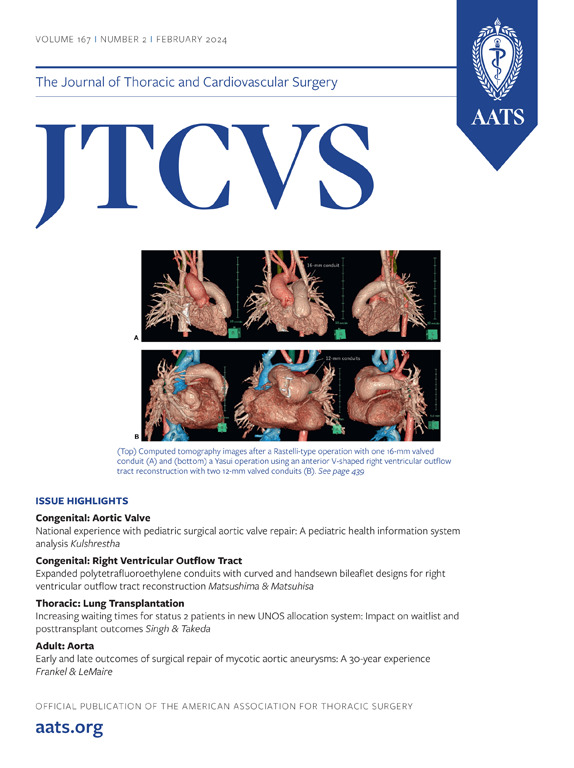机器人辅助扩展胸腺切除术治疗大面积可切除胸腺瘤:21 年的经验。
IF 4.9
1区 医学
Q1 CARDIAC & CARDIOVASCULAR SYSTEMS
Journal of Thoracic and Cardiovascular Surgery
Pub Date : 2025-02-01
DOI:10.1016/j.jtcvs.2024.08.005
引用次数: 0
摘要
研究目的本研究旨在评估与小胸腺瘤相比,机器人辅助胸腔镜手术(RATS)扩展胸腺瘤切除术对大型可切除胸腺瘤患者的围手术期和中期肿瘤治疗效果:这项回顾性单中心研究纳入了2003年1月至2024年2月期间接受RATS扩展胸腺切除术的204例胸腺瘤患者。根据胸腺瘤大小(5 厘米阈值)将患者分为两组:小型胸腺瘤(ST)组有 114 名患者(55.9%),大型胸腺瘤(LT)组有 90 名患者(44.1%)。两组患者在性别、年龄、老年患者比例或病理高危分类方面无明显差异。除了LT组的手术时间较长(P=0.009)外,两组在手术参数和术后效果方面均无差异。两组患者均未在30天内死亡。在中位随访 61.0 个月(95% CI:48.96-73.04)期间,有四名患者复发(1.96%)。两组患者的五年总生存率(OS)(P=0.25)或无复发生存率(RFS)(P=0.43)无明显差异:结论:RATS扩展胸腺切除术在治疗可切除的巨大胸腺瘤方面技术可行、安全有效。此外,在长达五年的中位随访期内,完全切除大胸腺肿瘤患者的中期疗效与小胸腺肿瘤患者相当。本文章由计算机程序翻译,如有差异,请以英文原文为准。
Robotic-assisted extended thymectomy for large resectable thymoma: 21 years’ experience
Objective
This study aims to evaluate the perioperative and midterm oncological outcomes of robotic-assisted thoracic surgery extended thymectomy for patients with large resectable thymomas compared with small thymomas.
Methods
This retrospective single-center study included 204 patients with thymomas who underwent robotic-assisted thoracic surgery extended thymectomy between January 2003 and February 2024. Patients were divided into 2 groups based on the thymoma size (5-cm threshold).
Results
The study comprised 114 patients (55.9%) in the small thymoma group and 90 patients (44.1%) in the large thymoma group. No significant differences were found between the groups regarding gender, age, proportion of elderly patients, or pathologic high-risk classifications. Apart from a longer operative time (P = .009) in the large thymoma group, no differences were observed between the 2 groups regarding surgical parameters and postoperative outcomes. No deaths occurred within 30 days in either group. During a median follow-up of 61.0 months (95% CI, 48.96-73.04), 4 patients experienced recurrence (1.96%). No significant differences in the 5-year overall survival (P = .25) or recurrence-free survival (P = .43) were observed between groups.
Conclusions
Robotic-assisted thoracic surgery extended thymectomy is technically feasible, safe, and effective for treating large resectable thymomas. Moreover, midterm outcomes for patients with completely resected large thymomas were comparable to those with small thymomas during a median follow-up period of up to 5 years.
求助全文
通过发布文献求助,成功后即可免费获取论文全文。
去求助
来源期刊
CiteScore
11.20
自引率
10.00%
发文量
1079
审稿时长
68 days
期刊介绍:
The Journal of Thoracic and Cardiovascular Surgery presents original, peer-reviewed articles on diseases of the heart, great vessels, lungs and thorax with emphasis on surgical interventions. An official publication of The American Association for Thoracic Surgery and The Western Thoracic Surgical Association, the Journal focuses on techniques and developments in acquired cardiac surgery, congenital cardiac repair, thoracic procedures, heart and lung transplantation, mechanical circulatory support and other procedures.

 求助内容:
求助内容: 应助结果提醒方式:
应助结果提醒方式:


